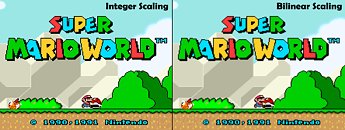Saturday, July 13th 2019

Intel adds Integer Scaling support to their Graphics lineup
Intel's Lisa Pearce today announced on Twitter, that the company has listened to user feedback from Reddit and will add nearest neighbor integer scaling to their future graphics chips. Integer scaling is the holy grail for gamers using console emulators, because it will give them the ability to simply double/triple or quadruple existing pixels, without any loss in sharpness that is inherent to traditional upscaling algorithms like bilinear or bicubic. This approach also avoids ringing artifacts that come with other, more advanced, scaling methods.
In her Twitter video, Lisa explained that this feature will only be available on upcoming Gen 11 graphics and beyond - previous GPUs lack the hardware required for implementing integer scaling. In terms of timeline, she mentioned that this will be part of the driver "around end of August", which also puts some constraints of the launch date of Gen 11, which seems to be rather sooner than later, based on that statement.It is unclear at this time, whether the scaling method is truly "integer" or simply "nearest neighbor". While "integer scaling" is nearest neighbor at its core, i.e. it picks the closest pixel color and does no interpolation, the difference is that "integer scaling" uses only integer scale factors. For example, Zelda Breath of the Wild runs at 900p natively, which would require a 2.4x scaling factor for a 4K display. Integer scaling would use a scale factor of x2, resulting in a 1800p image, with black borders on top - this is what the gamers want. The nearest neighbor image would not have the black bars, but every second pixel would be tripled instead of doubled, to achieve the 2.4x scaling factor, but resulting in a sub-optimal presentation.
Update Jul 13: Intel has posted an extensive FAQ on their website, which outlines the details of their Integer Scaling implementation, and we can confirm that it is done correctly - the screenshots clearly show black borders all around the upscaled image, which is exactly what you would expect for scaling with integer scale factors. Intel does provide two modes, called "NN" (Nearest Neighbor) and "IS" (Integer Scaling).
Sources:
Twitter, FAQ on Intel Website
In her Twitter video, Lisa explained that this feature will only be available on upcoming Gen 11 graphics and beyond - previous GPUs lack the hardware required for implementing integer scaling. In terms of timeline, she mentioned that this will be part of the driver "around end of August", which also puts some constraints of the launch date of Gen 11, which seems to be rather sooner than later, based on that statement.It is unclear at this time, whether the scaling method is truly "integer" or simply "nearest neighbor". While "integer scaling" is nearest neighbor at its core, i.e. it picks the closest pixel color and does no interpolation, the difference is that "integer scaling" uses only integer scale factors. For example, Zelda Breath of the Wild runs at 900p natively, which would require a 2.4x scaling factor for a 4K display. Integer scaling would use a scale factor of x2, resulting in a 1800p image, with black borders on top - this is what the gamers want. The nearest neighbor image would not have the black bars, but every second pixel would be tripled instead of doubled, to achieve the 2.4x scaling factor, but resulting in a sub-optimal presentation.
Update Jul 13: Intel has posted an extensive FAQ on their website, which outlines the details of their Integer Scaling implementation, and we can confirm that it is done correctly - the screenshots clearly show black borders all around the upscaled image, which is exactly what you would expect for scaling with integer scale factors. Intel does provide two modes, called "NN" (Nearest Neighbor) and "IS" (Integer Scaling).
Will Intel implement pure integer scaling with borders?
Yes, the driver being released in late August will provide users with the option to force integer scaling. The IS option will restrict scaling of game images to the greatest possible integer multiplier. The remaining screen area will be occupied by a black border, as mentioned earlier.



56 Comments on Intel adds Integer Scaling support to their Graphics lineup
Texture filtering, is exposed through APIs like OpenGL, Vulkan or Direct3D, but it's up to the driver to choose how to implement it. Textures are usually transformed and sampled by the TMUs in the GPU, so the texture filtering has to be tied to it, because the difference in nearest neighbor vs. linear filtering is where the texture is sampled. There are also other things to consider like clamping and wrapping/repeating which affects texture sampling.
This is done in hardware, at least for Nvidia and AMD GPUs. I know that Intel have emulated some things in software in the past, but I would be very surprised if they did texture filtering in software. And it's not like nearest filtering is primarily a "emulator" thing; it's useful whenever you want to render a texture which is not interpolated, like in GUIs, fonts, etc.
My point is, why all this fuzz about nearest neighbor filtering? It's an essential feature for all graphics APIs. Intel would be pretty stupid to not have it in hardware. I suspect this whole thing is more about technical details being lost in translation between technical staff and PR.A mipmap is a lower resolution texture. When you sample a texture in the lower resolution mipmap, you will effectively get an averaged value for that part of the texture. This is why Trilinear filtering gives a more blurred picture than bilinear filtering.
As explained a few posts up, I detailed how easy it is to achieve this integer scaling with any resolution, and I assume Intel is talking of a feature which implements this without application support. I kindly suggest reading it again.
My confusion is why Intel needs to "implement hardware support", implement hardware support for what precisely?. The scaling itself is done by nearest neighbor filtering when rendering one framebuffer into another, which is already implemented in all the APIs, so the only thing they need to implement is the usage of it to achieve "integer scaling". That sounds more like something that needs software support rather than hardware support, as this is an "application level" feature.